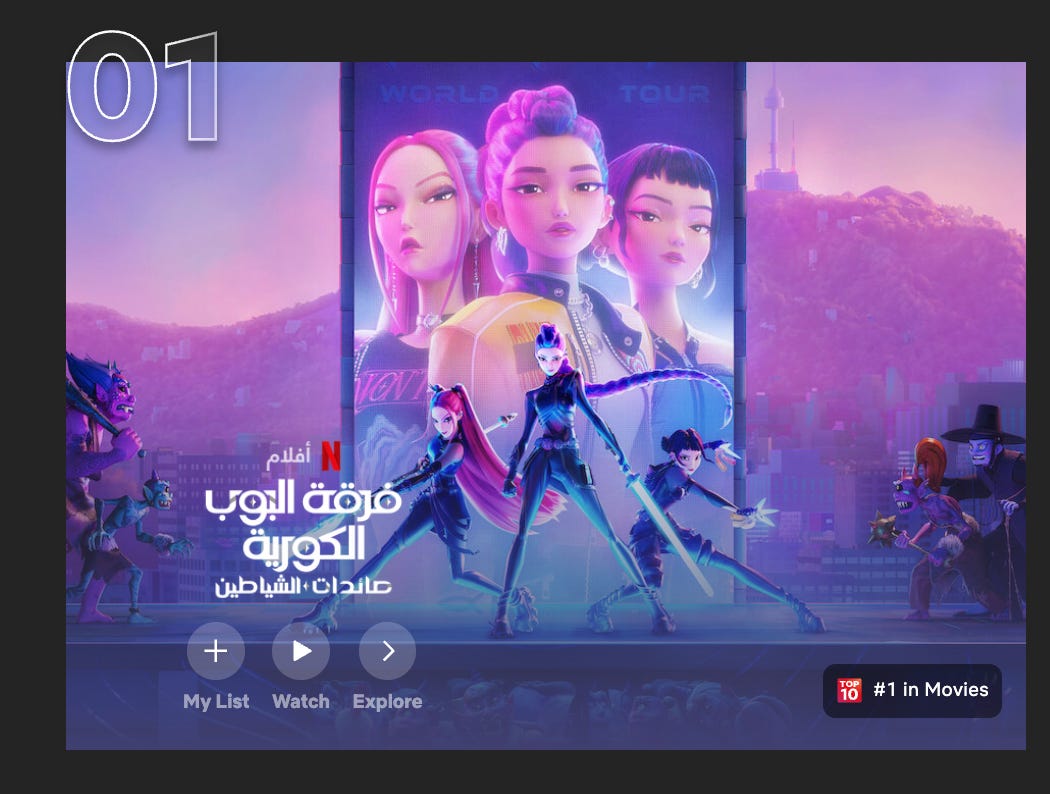👩🎤 K-Pop Demon Hunters in MENA: A Global Hit with Local Impact
How Netflix #1 movie connected with audiences in MENA
Hey streamers, today let’s talk about the most-watched movie ever on Netflix 👇
314 million views.
That’s how many people need to watch for a movie to reach #1 on Netflix’s all-time global list.
And the surprise? It’s not a big action film with Hollywood stars. It’s K-Pop Demon Hunters, a musical animated movie in English and Korean.
The film launched on June 20. In just a few weeks, it climbed past Red Notice and Carry-on to take the top spot on Netflix. Even more impressive: it’s the only animated movie in Netflix’s all-time Top 10.
So the question is: did K-Pop Demon Hunters also win over audiences in MENA? And if yes, why?
Read on to learn about:
The Korean & Anime Waves in MENA: How this type of content became popular in the region?
My Analysis: How K-Pop Demon Hunters performed in MENA.
So What? What we can learn from it
The Korean & Anime Waves in MENA
First, let’s be clear on what K-Pop Demon Hunters actually is.
It’s a Netflix animated musical fantasy, about 1 hour and 30 minutes long. The story follows Huntr/x, a K-pop girl group who shine on stage but secretly fight demons. Their rivals, the Saja Boys, are demons in disguise, threatening both their fans and the world.
The movie blends pop music, action, and fantasy. It feels like a concert and an adventure at the same time. Even though it’s mainly in English (with just a few Korean lyrics), the whole story is built around Korean culture, K-pop, and its universe.
So, let’s look at the two big categories behind this movie: Korean content and Anime in MENA.
Six months ago, I looked at how much Korean content was available on local streaming services in MENA, and the truth was disappointing.
Here’s what I found:
Only Viu had made Korean shows a clear part of its strategy, placing them alongside Turkish and Arabic series.
Other platforms, Shahid, STARZPLAY, 1001, Noor Play, were still in “testing mode”, each with a limited number of Korean titles.
Dedicated Korean carousels were rare, often hidden at the bottom of homepages.
Compared to Netflix, with its hundreds of Korean titles and heavy promotion, local players were far behind. If you want more details, I shared all my findings in this special report 👇
—
Now, let’s turn to Anime.
I know K-Pop Demon Hunters is not an anime in the strict sense. Anime usually refers to Japanese animation (or “hanguk aeni” for Korean animation). But this movie clearly has an anime-inspired visual style.
That’s why it’s important to look at how this type of content has been received in MENA, and why audiences here are already familiar with it.
Anime has been strong in MENA for decades, thanks to early Arabic dubbing. Classics like Grendizer and Captain Majid (Captain Tsubasa) aired in the 70s and 80s with Arabic voices and songs, making them feel local. Generations grew up with these shows, which is why anime still has a loyal fan base today.
You could find anime on local platforms like Shahid and STARZPLAY. But interesting moves happened recently:
Yango Play partnered with Crunchyroll, offering a bundle subscription, including the full Yango Play package plus Crunchyroll huge anime library.
A few weeks later, TOD (beIN streaming service) also signed with Crunchyroll, bringing a smaller selection of titles to its platform.
You’ll find more details about this bundle here:
So, while Korean content and Anime are both full of potential in MENA, they’re still treated as niche or specialty categories.
Which brings us back to K-Pop Demon Hunters.
I tracked its Netflix Top 10 ranking across 10 MENA countries: UAE, KSA, Egypt, Bahrain, Jordan, Kuwait, Lebanon, Morocco, Oman, and Qatar, since its launch in June.
The question I answered is: did K-Pop Demon Hunters really break through in these markets? 👇





